Click on images to enlarge
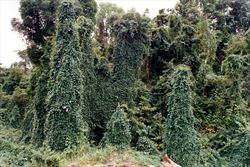
infestation (Photo: Land Protection, QDNRW)

infestation (Photo: Sheldon Navie)

habit (Photo: Sheldon Navie)
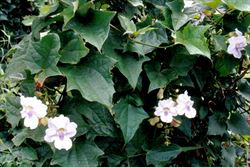
habit (Photo: Land Protection, QDNRW)
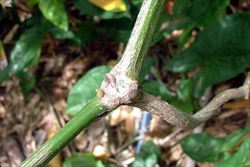
older stems (Photo: Sheldon Navie)

relatively long and hairy leaf stalks (Photo: Sheldon Navie)

deeply-lobed leaf (Photo: Sheldon Navie)

shallowly-lobed leaf (Photo: Sheldon Navie)

hairy leaf underside (Photo: Sheldon Navie)
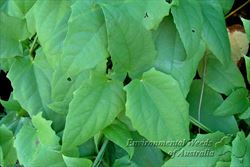
narrow leaves (photo: Sheldon Navie)

flowers and floral bracts (Photo: Land Protection, QDNRW)
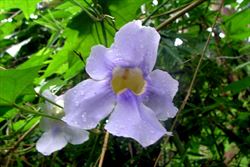
flowers and floral bracts (Photo: Land Protection, QDNRW)

leaf and mature fruit (Photo: Land Protection, QDNRW)

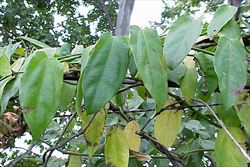
almost entire leaves (Photo: Sheldon Navie)
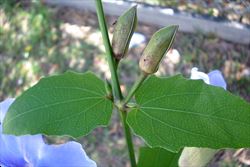
short leaf stalks and flower buds (Photo: Sheldon Navie)
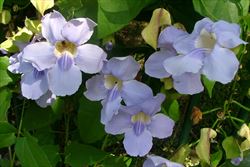
flowers (Photo: Sheldon Navie)
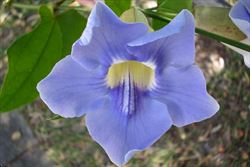
close-up of flower (Photo: Sheldon Navie)
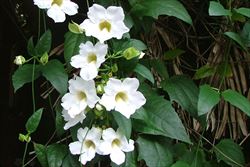
Thunbergia grandiflora 'Alba' (Photo: Sheldon Navie)
Scientific Name
Thunbergia grandiflora (Roxb. ex Rottler) Roxb.
Synonyms
Thunbergia laurifolia Lindl.
Flemingia grandiflora Roxb. ex Rottler
Family
Acanthaceae
Common Names
Bengal clock vine, Bengal clock-vine, Bengal clockvine, Bengal trumpet, Bengal trumpet vine, blue sky flower, blue sky vine, blue skyflower, blue thunbergia, blue trumpet vine, blue trumpetvine, clock vine, giant thunbergia, green trumpet vine, Indian sky flower, large flowered thunbergia, large-flowered thunbergia, laural clockvine, sky flower, sky vine, skyflower vine, skyvine, thunbergia, trumpet vine
Origin
This species is native to the Indian sub-continent (i.e north-eastern India, Bhutan and Nepal), southern China and Myanmar.
Cultivation
Blue thunbergia (Thunbergia grandiflora) has been widely cultivated as a garden ornamental in tropical and sub-tropical regions for its attractive blue, mauve or sometimes white flowers.
Naturalised Distribution
Blue thunbergia (Thunbergia grandiflora ) is reasonably widespread in the coastal districts of northern Queensland and is most common in the Cook pastoral district. Scattered populations are also present in the coastal districts of central and south-eastern Queensland, NSW, NT and in northern WA.
Also naturalised in tropical South America, Central America (i.e. Costa Rica), south-eastern USA (i.e. Florida), the Mascarenes (i.e. the Seychelles and La Réunion) and on some Pacific islands (i.e. Fiji, Western Samoa, Palau and Hawaii).
Habitat
A weed of watercourses (i.e. riparian areas), disturbed closed forests, forest margins, open woodlands, roadsides, fence-lines, gardens and plantation crops in tropical and sub-tropical regions.
Habit
A long-lived (i.e. perennial), vigorous, climbing plant that can smother trees and grow up to 15 m in height.
Distinguishing Features
- a long-lived vine, with tuberous roots, that grows up to 15 m in height.
- its younger stems are square in cross-section and bear oppositely arranged leaves on stalks 4-12 cm long.
- these leaves are variable in shape and their margins usually have several large teeth or small pointed lobes.
- its pale blue, violet, mauve or sometimes white trumpet-shaped flowers (3-8 cm long and 6-8 cm across) have a pale yellow or whitish coloured throat.
- each flower is borne on a long stalk (4-5 cm long) and has two leafy bracts (15-40 mm long) at its base.
- its fruiting capsules, when produced, are rounded with a long tapered beak (2-5 cm long).
Stems and Leaves
Younger stems are green, hairy (i.e. pubescent), and square in cross-section (i.e. quadrangular). The older climbing stems are quite thick when mature, and they usually turn brown in colour and become somewhat rounded in shape.
The oppositely arranged leaves are borne on hairy stalks (i.e. pubescent petioles) 2-12 cm long. These leaves are variable in shape (8-22 cm long and 3-15 cm wide) and may have broad heart-shaped (i.e. cordate) bases, be somewhat triangular in shape, or be roughly egg-shaped in outline (i.e. ovate), or narrow. Their margins are also quite variable, and can range from being almost entire, to being irregularly toothed (i.e. crenated) or have several irregular, pointed lobes. The leaves are also bright green in colour and somewhat hairy (i.e. pubescent) or may lack hairs.
Flowers and Fruit
The trumpet-shaped (i.e. tubular) flowers are borne in elongated clusters (i.e. racemes) on long, drooping (i.e. pendent) branches. They are large and showy (3-8 cm long and 6-8 cm across) with five pale blue, violet, mauve or someitmes white coloured petal lobes and a pale yellow or whitish coloured throat. Each flower is borne on a stalk (i.e. pedicel) 4-5 cm long and has two leafy bracts (i.e. bracteoles) at its base. These bracts (15-40 mm long and 10-20 mm wide) are oblong or egg-shaped in outline (i.e. ovate) and have pointed tips (i.e. acuminate apices). The flowers also have hairy (i.e. pubescent) sepals that are fused together and reduced to a ring-like structure (i.e. calyx tube) that is greenish-coloured and may sometimes be streaked with purple or red. Flowering occurs throughout the year, but is most abundant during summer and autumn. [Note: there is also a relatively common white-flowered horticultural variety known as Thunbergia grandiflora 'Alba'].
The fruit is a capsule with a rounded (i.e. spherical) base (about 18 mm long and 13 mm across) and a long tapered beak (2-5 cm long and about 7 mm wide). These fruit are only produced in the warmer parts of northern Australia. The large, flattened (i.e. compressed), seeds (up to 10 mm across) are smooth on one side and warty on the other side.
Reproduction and Dispersal
This species reproduces via seed (but fruit are only produced in warmer climates) and is also capable of regenerating from stem fragments or portions of the tuberous roots.
It has been widely cultivated as an ornamental and is most commonly dispersed in dumped garden waste. The tuberous roots may also be spread during soil moving activities (e.g. roadworks) and by flood waters. Seeds are explosively released, and may be catapulted several meters when the ripe fruiting capsules split open at maturity.
Environmental Impact
Blue thunbergia (Thunbergia grandiflora) is regarded as a significant environmental weed in Queensland, and as a potential environmental weed or "sleeper weed" in the Northern Territory, Western Australia and New South Wales.
Legislation
This species is declared under legislation in the following states and territories:
- Queensland: Class 2 - landowners must take all reasonable steps to keep land free of this species (throughout the entire state). It is also illegal to sell a declared plant or its seed in this state. (peviously, Thunbergia laurifolia was listed as Class 1, now a synonym of Thunbergia grandiflora.
- Western Australia: Prohibited - on the prohibited species list and not permitted entry into the state.
Management
For information on the management of this species see the following resources:
- the Biosecurity Queensland Fact Sheet on thunbergia species, which is available online at https://www.daff.qld.gov.au/plants/weeds-pest-animals-ants/weeds/a-z-listing-of-weeds/photo-guide-to-weeds/thunbergia
Similar Species
Blue thunbergia (Thunbergia grandiflora) is relatively similar to fragrant thunbergia (Thunbergia fragrans), black-eyed Susan (Thunbergia alata) and the native species Thunbergia arnhemica.
Blue thunbergia (Thunbergia grandiflora) can be most easily distinguished from the other species by the following differences:
- black-eyed Susan (Thunbergia alata) has relatively small flowers (25-40 mm across) that are usually orange (white in Thunbergia alata 'Alba') with conspicuous blackish coloured throats that are quite narrow.
- fragrant thunbergia (Thunbergia fragrans) has moderately large flowers (about 50 mm across) that are entirely white in colour and have a very narrow throat.
- Thunbergia arnhemica has moderately large flowers (about 50 mm across) that are entirely white in colour and are bell-shaped with a relatively broad throat.

